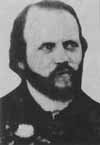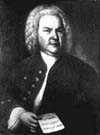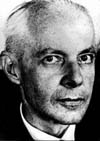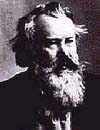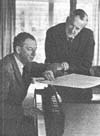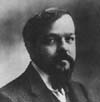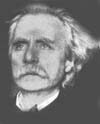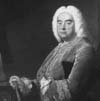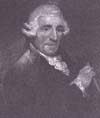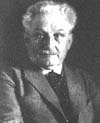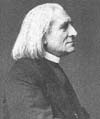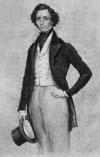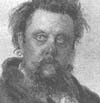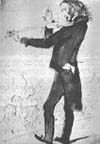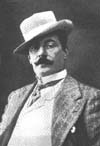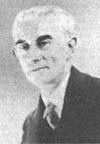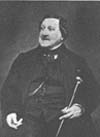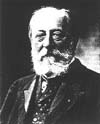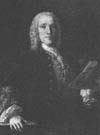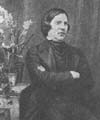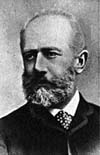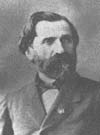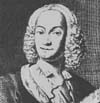| Classical composers biographies :
In Paris Alkan was a member of an accomplished social circle that included many of the leading names of his times in thought and the arts. In 1838 he appeared in concert with his close friend and neighbor, Frédéric Chopin, and was warmly received by critics and public alike. To this day there is no definitive explanation of what ensued from this point, though surmise and conjecture aplenty have flourished. For six years Alkan disappeared from the concert stage. He performed for nearly two years, then dematerialized as public pianist for 28 more years; when he again appeared he was past 60. I his time Alkan was considered the peer of Chopin and Franz Lizst in technique. He is widely thought of as an eccentric par excellence. In his later years he became intrigued with the pedalier, a pedal board that attaches to the piano and enables full performance of organ literature on the piano. He was fond of playing the compositions of Bach on this device, and composed copiously for it. His piano works require the utmost of skills, attesting to Alkan's own. Few performers care to attempt the difficulties of the Alkanian oeuvre in public, though some display their uncommon prowess by means of his works. The name of Alkan even now remains one capable of engendering vigorous debate in musical circles.
After competing unsuccessfully for an organist's post in Sangerhausen in 1702, Bach spent the spring and summer of 1703 as 'lackey' and violinist at the court of Weimar and then took up the post of organist at the Neukirche in Arnstadt. In June 1707 he moved to St. Blasius, Mühlhausen, and four months later married his cousin Maria Barbara Bach in nearby Dornheim. Bach was appointed organist and chamber musician to the Duke of Saxe-Weimar in 1708, and in the next nine years he became known as a leading organist and composed many of his finest works for the instrument. During this time he fathered seven children, including Wilhelm Friedemann and Carl Philipp Emanuel. When, in 1717, Bach was appointed Kapellmeister at Cöthen, he was at first refused permission to leave Weimar and was allowed to do so only after being held prisoner by the duke for almost a month. Bach's new employer, Prince Leopold, was a talented musician who loved and understood the art. Since the court was Calvinist, Bach had no chapel duties and instead concentrated on instrumental composition. From this period date his violin concertos and the six Brandenburg Concertos, as well as numerous sonalas, suites and keyboard works, including several (e.g. the Inventions and Book I of the '48') intended for instruction. In 1720 Maria Barbara died while Bach was visiting Karlsbad with the prince; in December of the following year Bach married Anna Magdalena Wilcke, daughter of a court trumpeter at Weissenfels. A week later Prince Leopold also married, and his bride's lack of interest in the arts led to a decline in the support given to music at the Cöthen court. In 1722 Bach entered his candidature for the prestigious post of Director musices at Leipzig and Kantor of the Thomasschule there. In April 1723, after the preferred candidates, Telemann and Graupner, had withdrawn, he was offered the post and accepted it. Bach remained as Thomaskantor in Leipzig for the rest of his life, often in conflict with the authorities, but a happy family man and a proud and caring parent. His duties centred on the Sunday and feastday services at the city's two main churches, and during his early years in Leipzig he composed prodigious quantities of church music, including four or five cantata cycles, the Magnificat and the St. John and St. Matthew Passions. He was by this time renowned as a virtuoso organist and in constant demand as a teacher and an expert in organ construction and design. His fame as a composer gradually spread more widely when, from 1726 onwards, he began to bring out published editions of some of his keyboard and organ music. From about 1729 Bach's interest in composing church music sharply declined, and most of his sacred works after that date, including the b Minor Mass and the Christmas Oratorio, consist mainly of 'parodies' or arrangements of earlier music. At the same time he took over the direction of the collegium musicum that Telemann had founded in Leipzig in 1702 - a mainly amateur society which gave regular public concerts. For these Bach arranged harpsichord concertos and composed several large-scale cantatas, or serenatas, to impress the Elector of Saxony, by whom he was granted the courtesy title of Hofcompositeur in 1736. Among the 13 children born to Anna Magdalena at Leipzig was Bach's youngest son, Johann Christian, in 1735. In 1744 Bach's second son, Emanuel, was married, and three years later Bach visited the couple and their son (his first grandchild) at Potsdam, where Emanuel was employed as harpsichordist by Frederick the Great. At Potsdam Bach improvised on a theme given to him by the king, and this led to the composition of the Musical Offering, a compendium of fugue, canon, and sonata based on the royal theme. Contrapuntal artifice predominates in the work of Bach's last decade, during which his membership (from 1747) of Lorenz Mizler's learned Society of Musical Sciences profoundly affected his musical thinking. The Canonic Variations for organ was one of the works Bach presented to the society, and the unfinished Art of Fugue may also have been intended for distribution among its members. Bach's eyesight began to deteriorate during his last year and in March and April 1750 he was twice operated on by the itinerant English oculist John Taylor. The operations and the treatment that followed them may have hastened Bach's death. He took final communion on 22 July and died six days later. On 31 July he was buried at St. John's cemetery. His widow survived him for ten years, dying in poverty in 1760. Bach's output embraces practically every musical genre of his time except for the dramatic ones of opera and oratorio (his three 'oratorios' being oratorios only in a special sense). He opened up new dimensions in virtually every department of creative work to which he turned, in format, musical quality and technical demands. As was normal at the time, his creative production was mostly bound up with the extemal factors of his places of work and his employers, but the density and complexity of his music are such that analysts and commentators have uncovered in it layers of religious and numerological significance rarely to be found in the music of other composers. Many of his contemporaries, notably the critic J.A. Scheibe, found his music too involved and lacking in immediate melodic appeal, but his chorale harmonizations and fugal works were soon adopted as models for new generations of musicians. The course of Bach's musical development was undeflected (though not entirely uninfluenced) by the changes in musical style taking place around him. Together with his great contemporary Handel (whom chance prevented his ever meeting), Bach was the last great representative of the Baroque era in an age which was already rejecting the Baroque aesthetic in favour of a new,'enlightened'one.
In 1904 Kossuth was performed in Budapest and Manchester; at the same time Bartók began to make a career as a pianist, writing a Piano Quintet and two Lisztian virtuoso showpieces (Rhapsody op.1, Scherzo op.2). Also in 1904 he made his first Hungarian folksong transcription. In 1905 he collected more songs and began his collaboration with Kodály: their first arrangements were published in 1906. The next year he was appointed Thoman's successor at the Budapest Academy, which enabled him to settle in Hungary and continue his folksong collecting, notably in Transylvania. Meanwhile his music was beginning to be influenced by this activity and by the music of Debussy that Kodály had brought back from Paris: both opened the way to new, modal kinds of harmony and irregular metre. The 1908 Violin Concerto is still within the symphonic tradition, but the many small piano pieces of this period show a new, authentically Hungarian Bartók emerging, with the 4ths of Magyar folksong, the rhythms of peasant dance and the scales he had discovered among Hungarian, Romanian and Slovak peoples. The arrival of this new voice is documented in his String Quartet no.1 (1908), introduced at a Budapest concert of his music in 1910. There followed orchestral pieces and a one-act opera, Bluebeard's Castle, dedicated to his young wife. Influenced by Mussorgsky and Debussy but most directly by Hungarian peasant music (and Strauss, still, in its orchestral pictures), the work, a grim fable of human isolation, failed to win the competition in which it was entered. For two years (1912-14) Bartok practically gave up composition and devoted himself to the collection, arrangement and study of folk music, until World War I put an end to his expeditions. He returned to creative activity with the String Quartet no.2 (1917) and the fairytale ballet The Wooden Prince, whose production in Budapest in 1917 restored him to public favour. The next year Bluebeard's Castle was staged and he began a second ballet, The Miraculous Mandarin, which was not performed until 1926 (there were problems over the subject, the thwarting and consummation of sexual passion). Rich and graphic in invention, the score is practically an opera without words. While composing The Mandarin Bartók came under the influence of Stravinsky and Schönberg, and produced some of his most complex music in the two violin sonatas of 1921-2. At the same time he was gaining international esteem: his works were published by Universal Edition and he was invited to play them all over Europe. He was now well established, too, at home. He wrote the confident Dance Suite (1923) for a concert marking the 50th anniversary of Budapest, though there was then another lull in his composing activity until the sudden rush of works in 1926 designed for himself to play, including the Piano Concerto no.1, the Piano Sonata and the suite Out of Doors. These exploit the piano as a percussion instrument, using its resonances as well as its xylophonic hardness. The search for new sonorities and driving rhythms was continued in the next two string quartets (1927-8), of which no.4, like the concerto, is in a five-section palindromic pattem (ABCBA). Similar formal schemes, with intensively worked counterpoint, were used in the Piano Concerto no.2 (1931) and String Quartet no.5 (1934), though now Bartók's harmony was becoming more diatonic. The move from inward chromaticism to a glowing major (though modally tinged) tonality is basic to the Music for Strings, Percussion and Celesta (1936) and the Sonata for Two Pianos and Percussion (1937), both written for performance in Switzerland at a time when the political situation in Hungary was growing unsympathetic. In 1940 Bartók and his second wife (he had divorced and remarried in 1923) sadly left war-torn Europe to live in New York, which he found alien. They gave concerts and for a while he had a research grant to work on a collection of Yugoslav folksong, but their finances were precarious, as increasingly was his health. It seemed that his last European work the String Quartet no.6 (1939), might be his pessimistic swansong, but then came the exuberant Concerto for Orchestra (1943) and the involuted Sonata for solo violin (1944). Piano Concerto no.3, written to provide his widow with an income, was almost finished when he died, a Viola Concerto left in sketch.
1802, however, was a year of crisis for Beethoven, with his realization that the impaired hearing he had noticed for some time was incurable and sure to worsen. That autumn, at a village outside Vienna, Heiligenstadt, he wrote a will-like document, addressed to his two brothers, describing his bitter unhappiness over his affliction in terms suggesting that he thought death was near. But he came through with his determination strengthened and entered a new creative phase, generally called his 'middle period'. It is characterized by a heroic tone, evident in the Eroica Symphony (no.3, originally to have been dedicated not to a noble patron but to Napoleon), in Symphony no.5, where the sombre mood of the c Minor first movement ('Fate knocking on the door') ultimately yields to a triumphant C Major finale with piccolo, trombones and percussion added to the orchestra, and in his opera Fidelio. Here the heroic theme is made explicit by the story, in which (in the post-French Revolution 'rescue opera' tradition) a wife saves her imprisoned husband from murder at the hands of his oppressive political enemy. The three string quartets of this period, op.59, are similarly heroic in scale: the first, lasting some 45 minutes, is conceived with great breadth, and it too embodies a sense of triumph as the intense f Minor Adagio gives way to a jubilant finale in the major embodying (at the request of the dedicatee, Count Razumovsky) a Russian folk melody. Fidelio, unsuccessful at its premiere, was twice revised by Beethoven and his librettists and successful in its final version of 1814. Here there is more emphasis on the moral force of the story. It deals not only with freedom and justice, and heroism, but also with married love, and in the character of the heroine Leonore, Beethoven's lofty, idealized image of womanhood is to be seen. He did not find it in real life he fell in love several times, usually with aristocratic pupils (some of them married), and each time was either rejected or saw that the woman did not match his ideals. In 1812, however, he wrote a passionate love-letter to an 'Eternally Beloved' (probably Antonie Brentano, a Viennese married to a Frankfurt businessman), but probably the letter was never sent. With his powerful and expansive middle-period works, which include the Pastoral Symphony (no.6, conjuring up his feelings about the countryside, which he loved), Symphony no.7 and Symphony no. 8, Piano Concertos nos.4 (a lyrical work) and 5 (the noble and brilliant Emperor) and the Violin Concerto, as well as more chamber works and piano sonatas (such as the Waldstein and the Appassionata) Beethoven was firmly established as the greatest composer of his time. His piano-playing career had finished in 1808 (a charity appearance in 1814 was a disaster because of his deafness). That year he had considered leaving Vienna for a secure post in Germany, but three Viennese noblemen had banded together to provide him with a steady income and he remained there, although the plan foundered in the ensuing Napoleonic wars in which his patrons suffered and the value of Austrian money declined. The years after 1812 were relatively unproductive. He seems to have been seriously depressed, by his deafness and the resulting isolation, by the failure of his marital hopes and (from 1815) by anxieties over the custodianship of the son of his late brother, which involved him in legal actions. But he came out of these trials to write his profoundest music, which surely reflects something of what he had been through. There are seven piano sonatas in this, his 'late period', including the turbulent Hammerklavier op.106, with its dynamic writing and its harsh, rebarbative fugue, and op.110, which also has fugues and much eccentric writing at the instrument's extremes of compass; there is a great Mass and a Choral Symphony, no.9 in d Minor, where the extended variation-finale is a setting for soloists and chorus of Schiller's Ode to Joy; and there is a group of string quartets, music on a new plane of spiritual depth, with their exalted ideas, abrupt contrasts and emotional intensity. The traditional four-movement scheme and conventional forms are discarded in favour of designs of six or seven movements, some fugal, some akin to variations (these forms especially attracted him in his late years), some song-like, some martial, one even like a chorale prelude. For Beethoven, the act of composition had always been a struggle, as the tortuous scrawls of his sketchbooks show; in these late works the sense of agonizing effort is a part of the music. Musical taste in Vienna had changed during the first decades of the 19th century; the public were chiefly interested in light Italian opera (especially Rossini) and easygoing chamber music and songs, to suit the prevalent bourgeois taste. Yet the Viennese were conscious of Beethoven's greatness: they applauded the Choral Symphony even though, understandably, they found it difficuit, and though baffled by the late quartets they sensed their extraordinary visionary qualities. His reputation went far beyond Vienna: the late Mass was first heard in St. Petersburg, and the initial commission that produced the Choral Symphony had come from the Philharmonic Society of London. When, early in 1827, he died, 10,000 are said to have attended the funeral. He had become a public figure, as no composer had done before. Unlike composers of the preceding generation, he had never been a purveyor of music to the nobility he had lived into the age - indeed helped create it - of the artist as hero and the property of mankind at large.
Brahms's urge to hold an official position (connected in his mind with notions of social respectability) was again met by a brief conductorship - in 1872-3 of the Vienna Gesellschaftskonzerte - but the practical demands of the job conflicted with his even more intense longing to compose. Both the German Requiem (first complete performance, 1869) and the Variations on the St. Antony Chorale (1873) were rapturously acclaimed, bringing intemational renown and financial security. Honours from home and abroad stimulated a spate of masterpieces, including the First (1876) and Second (1877) Symphonies, the Violin Concerto (1878), the songs of opp.69-72 and the C major Trio. In 1881 Hans von Bülow became a valued colleague and supporter, 'lending' Brahms the fine Meiningen court orchestra to rehearse his new works, notably the Fourth Symphony (1885). At Bad Ischl, his favourite summer resort, he composed a series of important chamber works. By 1890 he had resolved to stop composing but nevertheless produced in 1891-4 some of his best instrumental pieces, inspired by the clarinettist Richard Mühlfeld. Soon after Clara Schumann's death in 1896 he died from cancer, aged 63, and was buried in Vienna. Fundamentally reserved, logical and studious, Brahms was fond of taut forms in his music, though he used genre distinctions loosely. In the piano music, for example, which chronologically encircles his vocal output, the dividing lines beteen ballade and rhapsody, and capriccio and intermezzo, are vague, such terms refer more to expressive character than to musical form. As in other media, his most important development technique in the piano music is variation, whether used independently (simple melodic alteration and thematic cross-reference) or to create a large integrated cycle in which successive variations contain their own thematic transformation (as in the Handel Variations). If producing chamber works without piano caused him difficulty, these pieces contain some of his most ingenious music, including the Clarinet Quintet and the three string quartets. Of the other chamber music, the eloquent pair of string sextets, the serious C minor Piano Quartet op.60 (known to be autobigraphical), the richly imaginative Piano Quintet and the fluent Clarinet Trio op.1l4 are noteworthy. The confidence to finish and present his First Symphony took Brahms 15 years for worries over not only his orchestral technique but the work's strongly Classical lines at a time when programmatic symphonies were becoming fashionable; his closely worked score led him to be hailed as Beethoven's true heir. In all four symphonies he is entirely personal in his choice of material, structural manipulation of themes and warm but lucid scoring. All four move from a weighty opening movement through loosely connected inner movements to a monumental finale. Here again his use of strict form, for example the ground bass scheme in the finale of the Fouth Symphony, is not only discreet but astonishingly effective. Among the concertos, the four-movement Second Piano Concerto in B-flat - on a grandly symphonic scale, demanding both physically and intellectually - and the Violin Concerto (dedicated to Joachim and lyrical as well as brilliant) are important, as too is the nobly rhetorical Double Concerto. Brahms's greatest vocal work, and a work central to his career, is the German Requiem (1868) combining mixed chorus, solo voices and full orchestra in a deeply felt, non-denominational statement of faith. More Romantic are the Schicksalslied and the Alto Rhapsody. Between these large choral works and the many a cappella ones showing his informed appreciation of Renaissance and Baroque polyphony (he was a diligent collector, scholar and editor of old music) stand the justly popular Zigeunerlieder (in modified gypsy style) and the landler-like Liebeslieder waltzes with piano accompaniment. His best-loved songs include, besides the narrative Magelone cycle and the sublime Vier ernste Gesänge, Mainacht, Feldeinsamkeit and Immer leiser wird mein Schlummer.
In 1939 he left England for the USA, with his lifelong companion Peter Pears; there he wrote his first opera, to Auden's libretto (Paul Bunyan, 1941). In 1942 he returned and, partly stimulated by Purcell, began to concentrate on settings of English verse (anthem Rejoice in the Lamb and Serenade for tenor, horn and strings, both 1943). His String Quartet no.2 (1945), with its huge concluding chaconne, also came out of his Purcellian interests, but the major work of this period was Peter Grimes (1945), which signalled a new beginning in English opera. Its central character, the first of many roles written for Pears, struck a new operatic tone: a social outcast, he is fiercely proud and independent, but also deeply insecure, providing opportunities for a lyrical flow that would be free but is not. Britten's gift for characterization was also displayed in the wide range of sharply defined subsidiary roles and in the orchestra's sea music. However, his next operas were all written for comparatively small resources (The Rape of Lucretia, 1946; Albert Herring, 1947; a version of The Beggar's Opera 1948; The Little Sweep, 1949), for the company that became established as the English Opera Group. At the same time he began writing music for the Aldeburgh Festival, which he and Pears founded in 1948 in the Suffolk town where they had settled (cantata St. Nicolas, 1948; Lachrymae for viola and piano, 1949). And in this prolific period he also composed large concert works (The Young Person's Guide to the Orchestra, 1946; Spring Symphony with soloists and choir, 1949) and songs. The pattern of his output was thus set, though not the style, for the operas show an outward urge to ever new subjects: village comedy in Albert Herring, psychological conflict in Billy Budd (1951), historical reconstruction in Gloriana (1953), a tale of ghostly possession in The Turn of the Screw (1954), nocturnal magic in A Midsummer Night's Dream (1960), a struggle between family history and individual responsibility in Owen Wingrave (1971) and, most centrally, obsession with a doomed ideal in Death in Venice (1973), the last three works being intermediate in scale between the chamber format of Herring and The Screw, and the symphonic fullness of Budd and Gloriana, both written for Covent Garden. But nearly all touch in some way on the themes of the individual and society and the violation of innocence. Simultaneous with a widening range of subject matter was a widening musical style, which came to include 12-note elements (Turn of the Screw) and a heterophony that owed as much to oriental music directly as it did to Mahler (cycle of 'church parables', or ritualized small-scale operas: Curlew River, The Burning Fiery Furnace, The Prodigal Son, 1964-8). Many of these dramatic works were written for the Aldeburgh Festival, as were many of the instrumental and vocal works Britten produced for favoured performers. For Rostropovich he wrote the Cello Symphony (1963) as well as a sonata and three solo suites; for Pears there was the Hardy cycle Winter Words (1953) among many other songs, and also a central part in the War Requiem (1961). His closing masterpiece, however, was a return to the abstract in the String Quartet no.3 (1975). Britten was appointed a Companion of Honour in 1952, to the Order of Merit in 1965, and was awarded a life peerage in 1976.
Chopin was born Frederic (spelled in Polish as Fryderyk) Francois (French) Chopin, his very name indicative of the blended impact two countries made on the precocious musician's life. His father, Nicholas Chopin, was a French tutor to many aristocratic Polish families, later accepting a position as a French teacher at the Warsaw Lyceum. Although Chopin later attended the Lyceum where his father taught, his early training began at home. This included receiving piano lessons from his mother. By the age of six, Chopin was creating original pieces, showing innate prodigious musical ability. His parents arranged for the young Chopin to take piano instruction from Wojciech Zywny. Zywny taught the boy the work of classical composers Bach, Mozart, and Beethoven, but with an ear open and sympathetic to the individualism infiltrating the music of a dawning Romantic Period. Artistically, this period represented an era dedicated to the creation of ideas and impressions, beauty, imagination and sentiment. The music synonymous with this time was intensely personal and emotional. Emphases were placed on color, tone, and dynamics, a rather impressive outbreak from the "follow the rules" Classical Period with its focus on structure and form. Wojciech Zywny's tutelage influenced the young Chopin perhaps immeasurably, as Chopin's compositions were Romantically expressive and emotional, yet defined by a purity derived from the Classical Period before him. When Chopin was sixteen, he attended the Warsaw Conservatory of Music, directed by composer Joseph Elsner. Elsner, like Zywny, insisted on the traditional training associated with Classical music but allowed his students to investigate the more original imaginations of the Romantic style as well. As often happened with the young musicians of both the Classical and Romantic Periods, Chopin was sent to Vienna, the unquestioned center of music for that day. He gave piano concerts and then arranged to have his pieces published by a Viennese publishing house there. While Chopin was in Austria, Poland and Russia faced off in the apparent beginnings of war. He returned to Warsaw to get his things in preparation of a more permanent move. While there, his friends gave him a silver goblet filled with Polish soil. He kept it always, as he was never able to return to his beloved Poland. His family forbade him to come home, fearful for his safety. French by heritage, and desirous of finding musical acceptance from a less traditional audience than that of Vienna, Chopin ventured to Paris. Interestingly, other young musicians had assembled in the city of fashion with the very same hope. Chopin joined Franz Liszt, Hector Berlioz, Felix Mendelssohn, Vincenzo Bellini, and Auguste Franchomme, all proponents of the "new" Romantic style. Although Chopin did play in the large concert halls on occasion, he felt most at home in private settings, enjoying the social milieu that accompanied concerts for the wealthy. He also enjoyed teaching, as this caused him less stress than performing. Chopin did not feel that his delicate technique and intricate melodies were as suited to the grandiose hall as they were to smaller environments and audiences. News of the war in Poland inspired Chopin to write many sad musical pieces expressing his grief for "his" Poland. Among these was the famous "Revolutionary Etude." Plagued by poor health as well as his homesickness, Chopin found solace in summer visits to the country. Here, his most complex yet harmonic creations found their way to the brilliant composer's hand. The "Fantaisie in F Minor," the "Barcarolle," the "Polonaise Fantaisie," "Ballade in A Flat Major," "Ballade in F Minor," and "Sonata in B Minor" were all products of the relaxed time Chopin enjoyed in the country. Prolific as this might seem, Chopin's earlier teacher, Elsner, voiced his disappointment in Chopin's inability to create an opera for the sake of Poland. As the war continued in Warsaw and then reached Paris, Chopin retired to Scotland with friends. Although he was far beyond the reach of the revolution, his melancholy attitude did not improve and he sank deeper into a depression. Likewise, his health did not rejuvenate either. A window in the fighting made it possible for Chopin to return to Paris as his health deteriorated further. Surrounded by those that he loved, Frederic Francois Chopin died at the age of 39. He was buried in Paris. Chopin's last request was that the Polish soil in the silver goblet be sprinkled over his grave.
Pelléas, with its rule of understatement and deceptively simple declamation, also brought an entirely new tone to opera - but an unrepeatable one. Debussy worked on other opera projects and left substantial sketches for two pieces after tales by Poe (Le diable dans le beffroi and La chûte de la maison Usher), but nothing was completed. Instead the main works were orchestral pieces, piano sets and songs. The orchestral works include the three Nocturnes (1899), characteristic studies of veiled harmony and texture ('Nuages'), exuberant cross-cutting ('Fêtes') and seductive whole-tone drift ('Sirènes'). La mer (1905) essays a more symphonic form, with a finale that works themes from the first movement, though the centrepiece ('Jeux de vagues') proceeds much less directly and with more variety of colour. The three Images (1912) are more loosely linked, and the biggest, 'Ibéria', is itself a triptych, a medley of Spanish allusions. Finally the ballet Jeux (1913) contains some of Debussy's strangest harmony and texture in a form that moves freely over its own field of motivic connection. Other late stage works, including the ballets Khamma (1912) and La boîte à joujoux (1913) and the mystery play Le martyre de St. Sébastien (1911), were not completely orchestrated by Debussy, though St. Sébastien is remarkable in sustaining an antique modal atmosphere that otherwise was touched only in relatively short piano pieces (e.g.'La cathédrale engloutie'). The important piano music begins with works which, Verlaine fashion, look back at rococo decorousness with a modern cynicism and puzzlement (Suite bergamasque, 1890; Pour le piano, 1901). But then, as in the orchestral pieces, Debussy began to associate his music with visual impressions of the East, Spain, landscapes etc, in a sequence of sets of short pieces. His last volume of Etudes (1915) interprets similar varieties of style and texture purely as pianistic exercises and includes pieces that develop irregular form to an extreme as well as others influenced by the young Stravinsky (a presence too in the suite En blanc et noir for two pianos, 1915). The rarefaction of these works is a feature of the last set of songs, the Trois poèmes de Mallarmé (1913), and of the Sonata for flute, viola and harp (1915), though the sonata and its companions also recapture the inquisitive Verlainian classicism. The planned set of six sonatas was cut short by the composer's death from rectal cancer.
Grieg was first and foremost a lyrical composer; his op.33 Vinje settings, for example, encompass a wide range of emotional expression and atmospheric colour, and the ten opus numbers of Lyric Pieces for piano hold a wealth of characteristic mood-sketches. But he also was a pioneer, in the impressionistic uses of harmony and piano sonority in his late songs and in the dissonance treatment in the Slatter op.72, peasant fiddle-tunes arranged for piano.
He left Italy early in 1710 and went to Hanover, where he was appointed Kapellmeister to the elector. But he at once took leave to take up an invitation to London, where his opera Rinaldo was produced early in 1711. Back in Hanover, he applied for a second leave and returned to London in autumn 1712. Four more operas followed in 1712-15, with mixed success; he also wrote music for the church and for court and was awarded a royal pension. In 1716 he may have visited Germany (where possibly he set Brockes's Passion text); it was probably the next year that he wrote the Water Music to serenade George I at a river-party on the Thames. In 1717 he entered the service of the Earl of Carnarvon (soon to be Duke of Chandos) at Edgware, near London, where he wrote 11 anthems and two dramatic works, the evergreen Acis and Galatea and Esther, for the modest band of singers and players retained there. In 1718-19 a group of noblemen tried to put Italian opera in London on a firmer footing, and launched a company with royal patronage, the Royal Academy of Music; Handel, appointed musical director, went to Germany, visiting Dresden and poaching several singers for the Academy, which opened in April 1720. Handel's Radamisto was the second opera and it inaugurated a noble series over the ensuing years including Ottone, Giulio Cesare, Rodelinda, Tamerlano and Admeto. Works by Bononcini (seen by some as a rival to Handel) and others were given too, with success at least equal to Handel's, by a company with some of the finest singers in Europe, notably the castrato Senesino and the soprano Cuzzoni. But public support was variable and the financial basis insecure, and in 1728 the venture collapsed. The previous year Handel, who had been appointed a composer to the Chapel Royal in 1723, had composed four anthems for the coronation of George II and had taken British naturalization. Opera remained his central interest, and with the Academy impresario, Heidegger, he hired the King's Theatre and (after a journey to Italy and Germany to engage fresh singers) embarked on a five-year series of seasons starting in late 1729. Success was mixed. In 1732 Esther was given at a London musical society by friends of Handel's, then by a rival group in public; Handel prepared to put it on at the King's Theatre, but the Bishop of London banned a stage version of a biblical work. He then put on Acis, also in response to a rival venture. The next summer he was invited to Oxford and wrote an oratorio, Athalia, for performance at the Sheldonian Theatre. Meanwhile, a second opera company ('Opera of the Nobility', including Senesino) had been set up in competition with Handel's and the two competed for audiences over the next four seasons before both failed. This period drew from Handel, however, such operas as Orlando and two with ballet, Ariodante and Alcina, among his finest scores. During the rest of the 1730s Handel moved between Italian opera and the English forms, oratorio, ode and the like, unsure of his future commercially and artistically. After a joumey to Dublin in 1741-2, where Messiah had its premiere (in aid of charities), he put opera behind him and for most of the remainder of his life gave oratorio performances, mostly at the new Covent Garden theatre, usually at or close to the Lent season. The Old Testament provided the basis for most of them (Samson, Belshazar, Joseph. Joshua, Solomon, for example), but he sometimes experimented, turning to classical mythology (Semele, Hercules) or Christian history (Theodora), with little public success. All these works, along with such earlier ones as Acis and his two Cecilian odes (to Dryden words), were performed in concert form in English. At these performances he usually played in the interval a concerto on the organ (a newly invented musical genre) or directed a concerto grosso (his op.6, a set of 12, published in 1740, represents his finest achievement in the form). During his last decade he gave regular performances of Messiah, usually with about 16 singers and an orchestra of about 40, in aid of the Foundling Hospital. In 1749 he wrote a suite for wind instruments (with optional strings) for performance in Green Park to accompany the Royal Fireworks celebrating the Peace of Aix-la-Chapelle. His last oratorio, composed as he grew blind, was Jephtha (1752); The Triumph of Time and Truth (1757) is largely composed of earlier material. Handel was very economical in the re-use of his ideas; at many times in his life he also drew heavily on the music of others (though generally avoiding detection) - such 'borrowings' may be of anything from a brief motif to entire movements, sometimes as they stood but more often accommodated to his own style. Handel died in 1759 and was buried in Westminster Abbey, recognized in England and by many in Germany as the greatest composer of his day. The wide range of expression at his command is shown not only in the operas, with their rich and varied arias, but also in the form he created, the English oratorio, where it is applied to the fates of nations as well as individuals. He had a vivid sense of drama. But above all he had a resource and originality of invention, to be seen in the extraordinary variety of music in the op.6 concertos, for example, in which melodic beauty, boldness and humour all play a part, that place him and J.S. Bach as the supreme masters of the Baroque era in music.
Among the operas from this period are Lo speziale (for the opening of the new house), L'infedeltà delusa (1773) and Il mondo della luna (1777). Operatic activity became increasingly central from the mid-1770s as regular performances came to be given at the new house. It was part of Haydn's job to prepare the music, adapting or arranging it for the voices of the resident singers. In 1779 the opera house burnt down; Haydn composed La fedelta premiata for its reopening in 1781. Until then his operas had largely been in a comic genre; his last two for Eszterháza, Orlando paladino (1782) and Armida (1783), are in mixed or serious genres. Although his operas never attained wider exposure, Haydn's reputation had now grown and was international. Much of his music had been published in all the main European centres; under a revised contract with the Esterháza his employer no longer had exclusive rights to his music. His works of the 1780s that carried his name further afield include piano sonatas, piano trios, symphonies (nos.76-81 were published in 1784-5, and nos.82-7 were written on commission for a concert organization in Paris in 1785-6) and string quartets. His influential op.33 quartets, issued in 1782, were said to be 'in a quite new, special manner': this is sometimes thought to refer to the use of instruments or the style of thematic development, but could refer to the introduction of scherzos or might simply be an advertising device. More quartets appeared at the end of the decade, op.50 (dedicated to the King of Prussia and often said to be influenced by the quartets Mozart had dedicated to Haydn) and two sets (opp.54-5 and 64) written for a former Esterházy violinist who became a Viennese businessman. All these show an increasing enterprise, originality and freedom of style as well as melodic fluency, command of form, and humour. Other works that carried Haydn's reputation beyond central Europe include concertos and notturnos for a type of hurdy-gurdy, written on commission for the King of Naples, and The Seven Last Words, commissioned for Holy Week from Cadíz (Spain) Cathedral and existing not only in its original orchestral form but also for string quartet, for piano and (later) for chorus and orchestra. In 1790, Nikolaus Esterházy died; Haydn (unlike most of his musicians) was retained by his son but was free to live in Vienna (which he had many times visited) and to travel. He was invited by the impresario and violinist J.P. Salomon to go to London to write an opera, symphonies and other works. In the event he went to London twice, in 1791-2 and 1794-5. He composed his last 12 symphonies for performance there, where they enjoyed great success; he also wrote a symphonie concertante, choral pieces, piano trios, piano sonatas and songs (some to English words) as well as arranging British folksongs for publishers in London and Edinburgh. But because of intrigues his opera, L'anima del filosofo, on the Orpheus story, remained unperformed. He was honoured (with an Oxford DMus) and feted generously and played, sang and conducted before the royal family. He also heard performances of Handel's music by large choirs in Westminster Abbey. Back in Vienna, he resumed work for Nikolaus Esterházy's grandson (whose father had now died); his main duty was to produce masses for the princess's nameday. He wrote six works, firmly in the Austrian mass tradition but strengthened and invigorated by his command of symphonic technique. Other works of these late years include further string quartets (opp.71 and 74 between the London visits, op.76 and the op.77 pair after them), showing great diversity of style and seriousness of content yet retaining his vitality and fluency of utterance; some have a more public manner, acknowledging the new use of string quartets at concerts as well as in the home. The most important work, however, is his oratorio The Creation in which his essentially simple-hearted joy in Man, Beast and Nature, and his gratitude to God for his creation of these things to our benefit, are made a part of universal experience by his treatment of them in an oratorio modelled on Handel's, with massive choral writing of a kind he had not essayed before. He followed this with The Seasons, in a similar vein but more a series of attractive episodes than a whole. Haydn died in 1809, after twice dictating his recollections and preparing a catalogue of his works. He was widely revered, even though by then his music was old-fashioned compared with Beethoven's. He was immensely prolific: some of his music remains unpublished and little known. His operas have never succeeded in holding the stage. But he is regarded, with some justice, as father of the symphony and the string quartet: he saw both genres from their beginnings to a high level of sophistication and artistic expression, even if he did not originate them. He brought to them new intellectual weight, and his closely argued style of development laid the foundations for the larger structures of Beethoven and later composers.
In Brno, Janacek took up his former activities, and he also founded and directed an organ school and edited a new musical journal, Hudební listy. After composing his first opera, Sárka, he immersed himself in collecting and studying Moravian folk music, which bore fruit in a series of orchestral suites and dances and in a one-act opera, The Beginning of a Romance. This was favourably received in 1894, but Janacek withdrew it after six performances and set to work on Jenufa. During the long period of composition of Jenufa (1894-1903), Janacek rethought his approach to opera and to composition in general. He largely abandoned the number opera, integrated folksong firmly into his music and formulated a theory of 'speech-melody', based on the natural rhythms and the rise and fall of the Czech language, which was to influence all his ensuing works and give them a particular colour through their jagged rhythms and lines. Jenufa was soon followed by other operatic ventures, but his reputation in Brno was as a composer of instrumental and choral music and as director of the Organ School. Outside Moravia he was almost unknown until the Prague premiere of Jenufa in 1916. The creative upsurge of a man well into his 60s is explained partly by the success of Jenufa in Prague and abroad, partly by his patriotic pride in the newly acquired independence of his country, and perhaps most of all by his passionate, though generally distant, attachment to Kamila Stösslová, the young wife of an antique dealer in Pisek, Bohemia. Between 1919 and 1925 Janacek composed three of his finest operas, all on subjects with special resonances for him: Katya Kabanova with its neglected wife who takes a lover, The Cunning Little Vixen with its sympathetic portrayal of animals (and particularly the female fox), and The Makropoulos Affair with the 'ageless' woman who fascinates all men. Each was given first in Brno and soon after in Prague. His 70th birthday was marked by a doctorate from the Masaryk University in Brno. Early in 1926 he wrote the Sinfonietta for orchestra, characteristic in its blocks of sound and its forceful repetitions, and later that year his most important choral work, the Glagolitic Mass. While performance of his music carried his fame abroad, he started work on his last opera, From the House of the Dead, which he did not live to see performed. It received its premiere in April 1930 in a version prepared by his pupils Bretislav Bakala and Osvald Chlubna. Janacek's reputation outside Czechoslovakia and German-speaking countries was first made as an instrumental composer. He has since come to be regarded not only as a Czech composer worthy to be ranked with Smetana and Dvorak, but also as one of the most substantial and original opera composers of the 20th century.
He gave concerts in Paris, maintaining his legendary reputation, and published some essays, but was active chiefly as a composer (Annees de pèlerinage). To help raise funds for the Bonn Beethoven monument, he resumed the life of a travelling virtuoso (1839-47); he was adulated everywhere, from Ireland to Turkey, Portugal to Russia. In 1848 he took up a full-time conducting post at the Weimar court, where, living with the Princess Carolyne Sayn-Wittgenstein, he wrote or revised most of the major works for which he is known, conducted new operas by Wagner, Berlioz and Verdi and, as the teacher of Hans von Bülow and others in the German avant-garde, became the figurehead of the 'New German school'. In 1861-9 he lived mainly in Rome, writing religious works (he took minor orders in 1865); from 1870 he journeyed regularly between Rome, Weimar and Budapest. He remained active as a teacher and performer to the end of his life. Liszt's personality appears contradictory in its combination of romantic abstraction and otherworldliness with a cynical diabolism and elegant, worldly manners. But though he had a restless intellect, he also was ceaselessly creative, seeking the new in music. He helped others generously, as conductor, arranger, pianist or writer, and took artistic and personal risks in doing so. The greatest pianist of his time, he composed some of the most difficult piano music ever written (e.g. the Transcendental Studies) and had an extraordinarily broad repertory, from Scarlatti onwards; he invented the modern piano recital. Two formal traits give Liszt's compositions a personal stamp: experiment with large-scale structures (extending traditional sonata form, unifying multi-movement works), and thematic transformation, or subjecting a single short idea to changes of mode, rhythm, metre, tempo or accompaniment to form the thematic basis of an entire work (as in Les préludes, the Faust-Symphonie). His 'transcendental' piano technique was similarly imaginative, springing from a desire to make the piano sound like an orchestra or as rich in scope as one. In harmony he ventured well beyond the use of augmented and diminished chords and the whole-tone scale; the late piano and choral works especially contain tonal dashes arising from independent contrapuntal strands, chords built from 4ths or 5ths, and a strikingly advanced chromaticism. Piano works naturally make up the greater part of Liszt's output: they range from the brilliant early studies and lyric nature pieces of the first set of Annees de pèlerinage to the finely dramatic and logical b Minor Sonata, a masterpiece of 19th-century piano literature. The piano works from the 1870s onwards are more austere and withdrawn, some of them impressionistic, even gloomy (Anneés, third set). Not all the piano music is free of bombast but among the arrangements, the symphonic transcriptions (notably of Berlioz, Beethoven and Schubert) are often faithful and ingenious, the operatic fantasias (on Norma and Ernani, for example) more than mere salon pieces. Liszt invented the term 'sinfonische Dichtung' ('symphonic poem') for orchestral works that did not obey traditional forms strictly and were based generally on a literary or pictorial idea. Whether first conceived as overtures (Les préludes) or as works for other media (Mazeppa), these pieces all emphasize musical construction much more than scene-painting or story-telling. The three-movement Faust Symphonie too, with its vivid character studies of Faust, Gretchen and Mephistopheles, relies on technical artifice (especially thematic transformation) more than musical narrative to convey its message; it is often considered Liszt's supreme masterpiece. Although he failed in his aim to revolutionize liturgical music, Liszt did create in his psalm settings, Missa solemnis and the oratorio Christus some intensely dramatic and moving choral music, successful in his lifetime and well suited to concert performance.
A period of travel and concert-giving introduced Mendelssohn to England, Scotland (1829) and Italy (1830-31); after return visits to Paris (1831) and London (1832, 1833) he took up a conducting post at Düsseldorf (1833-5), concentrating on Handel's oratorios. Among the chief products of this time were The Hebrides (first performed in London, 1832), the g Minor Piano Concerto, Die erste Walpurgisnacht, the Italian Symphony (1833, London) and St. Paul (1836, Düsseldorf). But as a conductor and music organizer his most significant achievement was in Leipzig (1835-47), where to great acclaim he conducted the Gewandhaus Orchestra, championing both historical and modern works Bach, Beethoven, Weber, Schumann, Berlioz), and founded and directed the Leipzig Conservatory (1843). Composing mostly in the summer holidays, he produced Ruy Blas overture, a revised version of the Hymn of Praise, the Scottish Symphony, the now famous Violin Concerto op.64 and the fine Piano Trio in c Minor (1845). Meanwhile, he was intermittently (and less happily) employed by the king as a composer and choirmaster in Berlin, where he wrote highly successful incidental music, notably for A Midsummer Night's Dream (1843). Much sought after as a festival organizer, he was associated especially with the Lower Rhine and Birmingham music festivals; he paid ten visits to England, the last two (1840-7) to conduct Elijah in Birmingham and London. Always a warm friend and valued colleague, he was devoted to his family; his death at the age of 38, after a series of strokes, was mourned internationally. With its emphasis on clarity and adherence to classical ideals, Mendelssohn's music shows alike the influences of Bach (fugal technique), Handel (rhythms, harmonic progressions), Mozart (dramatic characterization, forms, textures) and Beethoven (instrumental technique), though from 1825 he developed a characteristic style of his own, often underpinned by a literary, artistic historical, geographical or emotional connection; indeed it was chiefly in his skilful use of extra-musical stimuli that he was a Romantic. His early and prodigious operatic gifts, clearly reliant on Mozart, failed to develop (despite his long search for suitable subjects), but his penchant for the dramatic found expression in the oratorios as well as in Ruy Blas overture, his Antigone incidental music and above all the enduring Midsummer Night's Dream music, in which themes from the overture are cleverly adapted as motifs in the incidental music. The oratorios, among the most popular works of their kind, draw inspiration from Bach and Handel and content from the composer's personal experience, St. Paul being an allegory of Mendelssohn's own family history and Elijah of his years of dissension in Berlin. Among his other vocal works, the highly dramatic Die erste Walpurgisnacht op.60 (on Goethe's poem greeting springtime) and the Leipzig psalm settings deserve special mention; the choral songs and lieder are uneven, reflecting their wide variety of social functions. After an apprenticeship of string symphony writing in a classical mould, Mendelssohn found inspiration in art, nature and history for his orchestral music. The energy, clarity and tunefulness of the Italian have made it his most popular symphony, although the elegiac Scottish represents a newer, more purposeful achievement. In his best overtures, essentially one-movement symphonic poems, the sea appears as a recurring image, from Calm Sea and Prosperous Voyage and The Hebrides to The Lovely Melusine. Less dependent on programmatic elements and at the same time formally innovatory, the concertos, notably that for violin, and the chamber music, especially some of the string quartets, the Octet and the two late piano trios, beautifully reconcile classical principles with personal feeling; these are among his most striking compositions. Of the solo instrumental works, the partly lyric, partly virtuoso Lieder ohne Worte for piano (from 1829) are elegantly written and often touching.
There he came under the influence of Giaches de Wert, whom he failed to succeed as maestro di cappella in 1596. In 1599 he married Claudia de Cattaneis, a court singer, who bore him three children, and two years later he was appointed maestro di cappella on Pallavicino's death. Largely as the result of a prolonged controversy with the theorist G.M. Artusi, Monteverdi became known as a leading exponent of the modem approach to harmony and text expression. In 1607 his first opera, Orfeo, was produced in Mantua, followed in 1608 by Arianna. Disenchanted with Mantua, he then retumed to Cremona, but failed to secure his release from the Gonzaga family until 1612, when Duke Vincenzo died. The dedication to Pope Paul V of a grand collection of church music known as the Vespers (1610) had already indicated an outwardlooking ambition, and in 1613 Monteverdi was appointed maestro di cappella at St. Mark's, Venice. There Monteverdi was active in reorganizing and improving the cappella as well as writing music for it, but he was also able to accept commissions from elsewhere, including some from Mantua, for example the ballet Tirsi e Clori (1616) and an opera, La finta pazza Licori (1627, not performed, now lost). He seems to have been less active after circa 1629, but he was again in demand as an opera composer on the opening of public opera houses in Venice from 1637. In 1640 Arianna was revived, and in the following two years Il ritorno d'Ulisse in patria, Le nozze d'Enea con Lavinia (lost) and L'incoronazione di Poppea were given first performances. In 1643 he visited Cremona and died shortly after his retum to Venice. Monteverdi can be justly considered one of the most powerful figures in the history of music. Much of his development as a composer may be observed in the eight books of secular madrigals published between 1587 and 1638. The early books show his indebtedness to Marenzio in particular; the final one, Madrigali guerrieri et amorosi, includes some pieces 'in genere rappresentativo' - Il ballo delle ingrate, the Combattimento di Tancredi e Clorinda and the Lamento della ninfa - which draw on Monteverdi's experience as an opera composer. A ninth book was issued posthumously in 1651. Orfeo was the first opera to reveal the potential of this then novel genre; Arianna (of which only the famous lament survives) may well have been responsible for its survival. Monteverdi's last opera, L'incoronazione di Poppea, though transmitted in not wholly reliable sources and including music by other men, is his greatest masterpiece and arguably the finest opera of the century. In the 1610 collection of sacred music Monteverdi displayed the multiplicity of styles that characterize this part of his output. The mass, written on themes from Gombert's motet In illo tempore, is a monument of the prima prattica or old style. At the other extreme the motets, written for virtuoso singers, are the most thorough-going exhibition of the modern style and the seconda prattica.
They spent 1769 in Salzburg; 1770-73 saw three visits to Italy, where Mozart wrote two operas (Mitridate, Lucio Silla) and a serenata for performance in Milan, and acquainted himself with Italian styles. Summer 1773 saw a further visit to Vienna, probably in the hope of securing a post; there Mozart wrote a set of string quartets and, on his return, wrote a group of symphonies including his two earliest, nos.25 in g Minor and 29 in A, in the regular repertory. Apart from a joumey to Munich for the premiere of his opera La finta giardiniera early in 1775, the period from 1774 to mid-1777 was spent in Salzburg, where Mozart worked as Konzertmeister at the Prince- Archbishop's court; his works of these years include masses, symphonies, all his violin concertos, six piano sonatas, several serenades and divertimentos and his first great piano concerto, K271. In 1777 the Mozarts, seeing limited opportunity in Salzburg for a composer so hugely gifted, resolved to seek a post elsewhere for Wolfgang. He was sent, with his mother, to Munich and to Mannheim, but was offered no position (though he stayed over four months at Mannheim, composing for piano and flute and falling in love with Aloysia Weber). His father then dispatched him to Paris: there he had minor successes, notably with his Paris Symphony, no.31, deftly designed for the local taste. But prospects there were poor and Leopold ordered him home, where a superior post had been arranged at the court. He returned slowly and alone; his mother had died in Paris. The years 1779-80 were spent in Salzburg, playing in the cathedral and at court, composing sacred works, symphonies, concertos, serenades and dramatic music. But opera remained at the centre of his ambitions, and an opportunity came with a commission for a serious opera for Munich. He went there to compose it late in 1780; his correspondence with Leopold (through whom he communicated with the librettist, in Salzburg) is richly informative about his approach to musical drama. The work, Idomeneo, was a success. In it Mozart depicted serious, heroic emotion with a richness unparalleled elsewhere in his works, with vivid orchestral writing and an abundance of profoundly expressive orchestral recitative. Mozart was then summoned from Munich to Vienna, where the Salzburg court was in residence on the accession of a new emperor. Fresh from his success, he found himself placed between the valets and the cooks; his resentment towards his employer, exacerbated by the Prince-Archbishop's refusal to let him perform at events the emperor was attending, soon led to conflict, and in May 1781 he resigned, or was kicked out of, his job. He wanted a post at the Imperial court in Vienna, but was content to do freelance work in a city that apparently offered golden opportunities. He made his living over the ensuing years by teaching, by publishing his music, by playing at patrons' houses or in public, by composing to commission (particularly operas); in 1787 he obtained a minor court post as Kammermusicus, which gave him a reasonable salary and required nothing beyond the writing of dance music for court balls. He always earned, by musicians' standards, a good income, and had a carriage and servants; through lavish spending and poor management he suffered times of financial difficulty and had to borrow. In 1782 he married Constanze Weber, Aloysia's younger sister. In his early years in Vienna, Mozart built up his reputation by publishing (sonatas for piano, some with violin), by playing the piano and, in 1782, by having an opera performed: Die Entführung aus dem Serail, a German Singspiel which went far beyond the usual limits of the tradition with its long, elaborately written songs (hence Emperor Joseph II's famous observation, 'Too many notes, my dear Mozart'). The work was successful and was taken into the repertories of many provincial companies (for which Mozart was not however paid). In these years, too, he wrote six string quartets which he dedicated to the master of the form, Haydn: they are marked not only by their variety of expression but by their complex textures, conceived as four-part discourse, with the musical ideas linked to this freshly integrated treatment of the medium. Haydn told Mozart's father that Mozart was 'the greatest composer known to me in person or by name; he has taste and, what is more, the greatest knowledge of composition'. In 1782 Mozart embarked on the composition of piano concertos, so that he could appear both as composer and soloist. He wrote 15 before the end of 1786, with early 1784 as the peak of activity. They represent one of his greatest achievements, with their formal mastery, their subtle relationships between piano and orchestra (the wind instruments especially) and their combination of brilliance, lyricism and symphonic growth. In 1786 he wrote the first of his three comic operas with Lorenzo da Ponte as librettist, Le nozze di Figaro: here and in Don Giovanni (given in Prague, 1787) Mozart treats the interplay of social and sexual tensions with keen insight into human character that - as again in the more artificial sexual comedy of Cosi fan tutte (1790) - transcends the comic framework, just as Die Zauberflöte (1791) transcends, with its elements of ritual and allegory about human harmony and enlightenment, the world of the Viennese popular theatre from which it springs. Mozart lived in Vienna for the rest of his life. He undertook a number of joumeys: to Salzburg in 1783, to introduce his wife to his family; to Prague three times, for concerts and operas; to Berlin in 1789, where he had hopes of a post; to Frankfurt in 1790, to play at coronation celebrations. The last Prague journey was for the premiere of La clemenza di Tito (1791), a traditional serious opera written for coronation celebrations, but composed with a finesse and economy characteristic of Mozart's late music. Instrumental works of these years include some piano sonatas, three string quartets written for the King of Prussia, some string quintets, which include one of his most deeply felt works (K516 in g Minor) and one of his most nobly spacious (K515 in C), and his last four symphonies - one (no.38 in D) composed for Prague in 1786, the others written in 1788 and forming, with the lyricism of no.39 in E-flat, the tragic suggestiveness of no.40 in g Minor and the grandeur of no.41 in C, a climax to his orchestral music. His final works include the Clarinet Concerto and some pieces for masonic lodges (he had been a freemason since 1784; masonic teachings no doubt affected his thinking, and his compositions, in his last years). At his death from a feverish illness whose precise nature has given rise to much speculation (he was not poisoned), he left unfinished the Requiem, his first large-scale work for the church since the c Minor Mass of 1783, also unfinished; a completion by his pupil Süssmayr was long accepted as the standard one but there have been recent attempts to improve on it. Mozart was buried in a Vienna suburb, with little ceremony and in an unmarked grave, in accordance with prevailing custom.
In 1858 Mussorgsky passed through a nervous or spiritual crisis and resigned his army commission. A visit to Moscow in 1859 fired his patriotic imagination and his compositional energies, but although his music began to enjoy public performances his nervous irritability was not entirely calmed. The emancipation of the serfs in March 1861 obliged him to spend most of the next two years helping manage the family estate; a symphony came to nothing and Stasov and Balakirev agreed that 'Mussorgsky is almost an idiot'. But he contiuned to compose and in 1863-6 worked on the libretto and music of an opera, Salammbô, which he never completed. At this time he served at the Ministry of Communications and lived in a commune with five other young men who ardently cultivated and exchanged advanced ideas about art, religion, philosophy and politics. Mussorgsky's private and public lives eventually came into conflict. In 1865 he underwent his first serious bout of dipsomania (probably as a reaction to his mother's death that year) and in 1867 he was dismissed from his post. Mussorgsky spent summer 1867 at his brother's country house at Minkino, where he wrote, among other things, his first important orchestral work, St. John's Night on the Bare Mountain. On his return to St. Petersburg in the autumn Mussorgsky, like the other members of the Balakirev-Stasov circle (ironically dubbed the 'Mighty Handful'), became interested in Dargomïzhsky's experiments in operatic naturalism. Early in 1869 Mussorgsky re-entered government service and, in more settled conditions, was able to complete the original version of the opera Boris Godunov. This was rejected by the Mariinsky Theatre and Mussorgsky set about revising it. In 1872 the opera was again rejected, but excerpts were performed elsewhere and a vocal score published. The opera committee finally accepted the work and a successtul production was mounted in February 1874. Meanwhile Mussorgsky had begun work on another historical opera, Khovanshchina, at the same time gaining promotion at the ministry. Progress on the new opera was interrupted partly because of unsettled domestic circumstances, but mainly because heavy drinking left Mussorgsky incapable of sustained creative effort. But several other compositions belong to this period, including the song cycles Sunless and Songs and Dances of Death and the Pictures at an Exhibition, for piano, a brilliant and bold series inspired by a memorial exhibition of drawings by his friend Victor Hartmann. Ideas for a comic opera based on Gogol's Sorochintsy Fair also began to compete with work on Khovanshchina; both operas remained unfinished at Mussorgsky's death. During the earlier part of 1878 he seems to have led a more respectable life and his director at the ministry even allowed him leave for a three-month concert tour with the contralto Darya Leonova. After he was obliged to leave the government service in January 1880, Leonova helped provide him with employment and a home. It was to her that he tumed on 23 February 1881 in a state of nervous excitement, saying that there was nothing left for him but to beg in the streets; he was suffering from alcoholic epilepsy. He was removed to hospital, where he died a month later. Many of Mussorgsky's works were unfinished, and their editing and posthumous publication were mainly carried out by Rimsky-Korsakov, who to a greater or lesser degree 'corrected' what Mussorgsky had composed. Boris Godunov, in particular, was reshaped and repolished, with drastic cuts, wholesale rewriting and rescoring, insertion of new music and transposition of scenes. It was only many years later that, with a return to the composer's original drafts, the true nature of his rough art could be properly understood, for Mussorgsky shared with some of the painters of his day a disdain for formal beauty, technical polish and other manifestations of 'art for art's sake'. His desire was to relate his art as closely as possible to life, especially that of the Russian masses, to nourish it on events and to employ it as a means for communicating human experience.
While still a student, Puccini entered a competition for a one-act opera announced in 1882 by the publishing firm of Sonzogno. He and his librettist, Ferdinando Fontana, failed to win, but their opera Le villi came to the attention of the publisher Giulio Ricordi, who arranged a successful production at the Teatro del Verme in Milan and commissioned a second opera. Fontana's libretto, Edgar, was unsuited to Puccini's dramatic talent and the opera was coolly received at La Scala in April 1889. It did, however, set the seal on what was to be Puccini's lifelong association with the house of Ricordi. The first opera for which Puccini himself chose the subject was Manon Lescaut. Produced at Turin in 1893, it achieved a success such as Puccini was never to repeat and made him known outside Italy. Among the writers who worked on its libretto were Luigi IlIica and Giuseppe Giacosa, who provided the librettos for Puccini's next three operas. The first of these, La bohème, widely considered Puccini's masterpiece, but with its mixture of lighthearted and sentimental scenes and its largely conversational style was not a success when produced at Turin in 1896. Tosca, Puccini's first excursion into verismo, was more enthusiastically received by the Roman audience at the Teatro Costanzi in 1900. Later that year Puccini visited London and saw David Belasco's one-act play Madam Butterfly. This he took as the basis for his next collaboration with Illica and Giacosa; he considered it the best and technically most advanced opera he had written. He was unprepared for the fiasco attending its first performance in February 1904, when the La Scala audience was urged into hostility, even pandemonium, by the composer's jealous rivals; in a revised version it was given to great acclaim at Brescia the following May. By then Puccini had married Elvira Gemignani, the widow of a Lucca merchant, who had borne him a son as long ago as 1896. The family lived until 1921 in the house at Torre del Lago which Puccini had acquired in 1891. Scandal was unleashed in 1909 when a servant girl of the Puccinis, whom Elvira had accused of an intimate relationship with her husband, committed suicide. A court case established the girl's innocence, but the publicity affected Puccini deeply and was the main reason for the long period before his next opera. This was La fanciulla del West, based on another Belasco drama; it was given its premiere at the Metropolitan Opera, New York, in December 1910. In all technical respects, notably its Debussian harmony and Straussian orchestration, it was a masterly reply to the criticism that Puccini repeated himself in every new opera. What it lacks is the incandescent phrase, and this is probably why it has not entered the normal repertory outside Italy. Differences with Tito Ricordi, head of the firm since 1912, led Puccini to accept a commission for an operetta from the directors of the Vienna Karltheater. The result, La rondine, though warmly received at Monte Carlo in 1917, is among Puccini's weakest works, hovering between opera and operetta and devoid of striking lyrical melody. While working on it Puccini began the composition of Il tabarro, the first of three one-act operas (Il trittico) which follow the scheme of the Parisian Grand Guignol - a horrific episode, a sentimental tragedy (Suor Angelica) and a comedy or farce (Gianni Schicchi). This last has proved to be the most enduring part of the triptych and is often done without the others, usually in a double bill. In his early 60s Puccini was determined to 'strike out on new paths' and started work on Turandot, based on a Gozzi play which satisfied his desire for a subject with a fantastic, fairy-tale atmosphere, but flesh-and-blood characters. During its composition he moved to Viareggio and in 1923 developed cancer of the throat. Treatment at a Brussels clinic seemed successful, but his heart could not stand the strain and he died, leaving Turandot unfinished. (It is usually played today with Franco Alfano's ending.) All Italy went into mourning and two years later his remains were interred at his house at Torre del Lago which, after his wife's death in 1930, was turned into a museum. Puccini's choral, orchestral and instrumental works, dating mainly from his early years, are unimportant, though the Mass in A-flat (1880) is still performed occasionally. His operas may not engage us on as many different levels as do those of Mozart, Wagner,Verdi or Strauss, but on his own most characteristic level, where erotic passion, sensuality, tenderness, pathos and despair meet and fuse, he was an unrivalled master. His melodic gift and harmonic sensibility, his consummate skill in orchestration and unerring sense of theatre combined to create a style that was wholly original, homogeneous and compelling. He was fully aware of his limitations and rarely ventured beyond them. He represents Verdi's only true successor, and his greatest masterpiece and swansong, Turandot, belongs among the last 20th-century stage works to remain in the regular repertory of the world's opera houses.
During the next decade, that of his 30s, he was at his most productive. There was a rivalry with Debussy and some dispute about priority in musical discoveries, but Ravel's taste for sharply defined ideas and closed formal units was entirely his own, as was the grand virtuosity of much of his piano music from this period, notably the cycles Miroirs and Gaspard de la nuit. Many works also show his fascination with things temporally or geographically distant, with moods sufficiently alien to be objectively drawn: these might be historical musical styles, as in the post-Schubertian Valses nobles et sentimentales, or the imagination of childhood, as in Ma mère l'oye. Or the composer's inspection might be turned on the East (Shéhérazade) or, as happened repeatedly, on Spain (Rapsodie espagnole, the comic opera L'heure espagnole). Or there might be a double focus, as in the vision of ancient Greece through the modification of 18th century French classicism in the languorous ballet Daphnis et Chloé, written for Dyagilev. The Ballets Russes were also important in introducing him to Stravinsky, with whom he collaborated on a version of Mussorgsky's Khovanshchina, and whose musical development he somewhat paralleled during the decade or so after The Rite of Spring. The set of three Mallarmé songs with nonet accompaniment were written partly under the influence of Stravinsky's Japanese Lyrics and Schönberg's Pierrot lunaire and the two sonatas of the 1920s can be compared with Stravinsky's abstract works of the period in their harmonic astringency and selfconscious use of established forms. However, Ravel's Le tombeau de Couperin, just as selfconscious, predates Stravinsky's neo-classicism, and the pressure of musical history is perhaps felt most intensely in the ballet La valse, where 3/4 rhythm develops into a dance macabre: both these works, like many others, exist in both orchestral and piano versions, testifying to Ravel's superb technique in both media (in 1922 he applied his orchestral skills tellingly to Mussorgsky's Pictures at an Exhibition). Other postwar works return to some of the composer's obsessions: with the delights and dangers of the child's world in the sophisticated fantasy opera L'enfant et les sortilèges, with musical Spanishness in Bolero and the songs for a projected Don Quixote film, and with the exotic in the Chansons madécasses. His last major effort was a pair of piano concertos, one exuberant and cosmopolitan (in G Major), the other (for left hand only) more darkly and sturdily single-minded. He died after a long illness.
This level of activity continued in the ensuing years. His first operas to win international acclaim come from 1813, written for different Venetian theatres: the serious Tancredi and the farcically comic L'italiana in Algeri, the one showing a fusion of lyrical expression and dramatic needs, with its crystalline melodies, arresting harmonic inflections and colourful orchestral writing, the other moving easily between the sentimental, the patriotic, the absurd and the sheer lunatic. Two operas for Milan were less successful. But in 1815 Rossini went to Naples as musical and artistic director of the Teatro San Carlo, which led to a concentration on serious opera. But he was allowed to compose for other theatres, and from this time date two of his supreme comedies, written for Rome, Il barbiere di Siviglia and La Cenerentola. The former, with its elegant melodies, its exhilarating rhythms and its superb ensemble writing, has claims to be considered the greatest of all Italian comic operas, eternally fresh in its wit and its inventiveness. It dates from 1816; initially it was a failure, but it quickly became the most loved of his comic works, admired alike by Beethoven and Verdi. The next year saw La Cenerentola, a charmingly sentimental tale in which the heroine moves from a touching folksy ditty as the scullery maid to brilliant coloratura apt to a royal maiden. Rossini's most important operas in the period that followed were for Naples. The third act of his Otello (1816), with its strong unitary structure, marks his maturity as a musical dramatist. The Neapolitan operas, even though much dependant on solo singing of a highly florid kind (to the extent that numbers could be, and have been, interchanged), show an enormous expansion of musical means, with more and longer ensembles and the chorus an active participant; the accompanied recitative is more dramatic and the orchestra is given greater prominence. Rossini also abandoned traditional overtures, probably in order to involve his audiences in the drama from the outset. In Naples the leading soprano was Isabella Colbran, mistress of the impresario, Barbaia. She transferred her allegiance to Rossini, who in 1822 married her; they were not long happy together. Among the masterpieces from this period are Maometto II (1820) and, written for Venice at the end of his time in Naples, Semiramide (1823). Barbaia gave a Viennese season in 1822; Rossini and his wife returned to Bologna, then in 1823 left for London and Paris where he took on the directorship of the Théâtre-Italien, composing for that theatre and the Opéra. Some of his Paris works are adaptations (Le siège de Corinthe and Moïse et Pharaon); the opéra comique Le Comte Ory is part-new, Guillaume Tell wholly. This last, widely regarded as his chef d'oeuvre, and very long, is a rich tapestry of his most inspired music, with elaborate orchestration, many ensembles, spectacular ballets and processions in the French tradition, opulent orchestral writing and showing a new harmonic boldness. And then, silence. At 37, he retired from opera composition. He left Paris in 1837 to live in Italy, but suffered prolonged and painful illness there (mainly in Bologna, where he advised at the Liceo Musicale, and in Florence). Isabella died in 1845 and the next year he married Olympe Pélissier, with whom he had lived for 15 years and who tended him through his ill-health. He composed hardly at all during this period (the Stabat mater belongs to his Paris years); but he went back to Paris in 1855, and his health and humour returned, with his urge to compose, and he wrote a quantity of pieces for piano and voices, with wit and refinement that he called Péchés de vieillesse ('Sins of Old Age') including the graceful and economical Petite messe solennelle (1863). He died, universally honoured, in 1868.
In 1719 Scarlatti resigned his positions in Rome and apparently spent some years in Palermo before taking up his next post, as mestre of the Portuguese court in Lisbon. The Lisbon earthquake of 1755 destroyed documents about his career there, but his duties included giving keyboard lessons to John V's daughter, Maria Barbara, and his younger brother, Don Antonio. When Maria Barbara married the Spanish crown prince in 1729 Scarlatti followed her to Seville and then, in 1733, to Madrid, where he spent the rest of his life. Although he continued to write vocal music, sacred and secular, the main works of his Iberian years are the remarkable series of keyboard sonatas, copied out in his last years and taken to Italy by his colleague, the castrato Farinelli. Scarlatti married twice: in 1728 a Roman, Maria Catarina Gentili, and in 1739 a Spaniard, Anastasia Maxarti Ximenes. None of his nine children became a musician. In 1738 he was honoured with a knighthood from King John V of Portugal, to which he responded by dedicating to the king a volume of Essercizi per gravicembalo, the only music published during his lifetime under his supervision. The seven operas Scarlatti wrote in Rome for Queen Maria Casimira were by no means failures, and his church music and secular cantatas contain much admirable music. But his fame rightly rests on the hundreds of keyboard sonatas, nearly all in the same binary form, in which he gave free rein to his imagination, stimulated by the new sounds, sights and customs of Iberia and by the astonishing gifts of his royal pupil and patron. In these he explored new worlds of virtuoso technique, putting to new musical ends such devices as hand-crossing, rapidly repeated notes, wide leaps in both hands and countless other means of achieving a devastating brilliance of effect.
In 1820-21 aristocratic patronage, further introductions and new friendships augured well. Schubert's admirers issued 20 of his songs by private subscription, and he and Schober collaborated on Alfonso und Estrella (later said to be his favourite opera). Though full of outstanding music, it was rejected. Strained friendships, pressing financial need and serious illness - Schubert almost certainly contracted syphilis in late 1822 - made this a dark period, which however encompassed some remarkable creative work: the epic 'Wanderer' Fantasy for piano, the passionate, two movement Eighth Symphony ('Unfinished'), the exquisite Schöne Müllerin song cycle, Die Verschworenen and the opera Fierabras (full of haunting music if dramatically ineffective). In 1824 he tumed to instrumental forms, producing the a Minor and d Minor ('Death and the Maiden') string quartets and the lyrically expansive Octet for wind and strings; around this time he at least sketched, probably at Gmunden in summer 1825, the 'Great' C Major Symphony. With his reputation in Vienna steadily growing (his concerts with Vogl were renowned, and by 1825 he was negotiating with four publishers), Schubert now entered a more assured phase. He wrote mature piano sonatas, notably the one in a Minor, some magnificent songs and his last, highly characteristic String Quartet, in G Major. 1827-8 saw not only the production of Winterreise and two piano trios but a marked increase in press coverage of his music; and he was elected to the Vienna Gesellschaft der Musikfreunde. But though he gave a full-scale public concert in March 1828 and worked diligently to satisfy publishers - composing some of his greatest music in his last year, despite failing health - appreciation remained limited. At his death, aged 31, he was mourned not only for his achievement but for 'still fairer hopes'. Schubert's fame was long limited to that of a songwriter, since the bulk of his large output was not even published, and some not even performed, until the late 19th century. Yet, beginning with the Fifth Symphony and the 'Trout' Quintet, he produced major instrumental masterpieces. These are marked by an intense lyricism (often suggesting a mood of near-pathos), a spontaneous chromatic modulation that is surprising to the ear yet clearly purposeful and often beguilingly expressive, and, not least, an imagination that creates its own formal structures. His way with sonata form, whether in an unorthodox choice of key for secondary material (Symphony in b Minor, 'Trout' Quintet) or of subsidiary ideas for the development, makes clear his maturity and individuality. The virtuoso 'Wanderer' Fantasy is equally impressive in its structure and use of cyclic form, while the String Quartet in G Major explores striking new sononties and by extension an emotional range of a violence new to the medium. The greatest of his chamber works however is acknowledged to be the String Quintet in C Major, with its rich sonorities, its intensity and its lyricism, and in the slow movement depth of feeling engendered by the sustained outer sections (with their insistent yet varied and suggestive accompanying ngures) embracing a central impassioned section in F minor. Among the piano sonatas, the last three, particularly the noble and spacious one in B-flat, represent another summit of achievement. His greatest orchestral masterpiece is the 'Great' C Major Symphony, with its remarkable formal synthesis, striking rhythmic vitality, felicitous orchestration and sheer lyric beauty. Schubert never abandoned his ambition to write a successful opera. Much of the music is of high quality (especially in Alfonso und Estrella, Fierabras and the attractive Easter oratorio Lazarus, closely related to the operas), showing individuality of style in both accompanied recitative and orchestral colour if little sense of dramatic progress. Among the choral works, the partsongs and the masses rely on homophonic texture and bold harmonic shifts for their effect; the masses in A-flat and E-flat are particularly successful. Schubert effectively established the German lied as a new art form in the 19th century. He was helped by the late 18th-century outburst of lyric poetry and the new possibilities for picturesque accompaniment offered by the piano, but his own genius is by far the most important factor. The songs fall info four main structural groups - simple strophic, modified strophic, through-composed (e.g. Die junge Nonne) and the 'scena' type (Der Wanderer); the poets range from Goethe, Schiller and Heine to Schubert's own versifying friends. Reasons for their abiding popularity rest not only in the direct appeal of Schubert's melody and the general attractiveness of his idiom but also in his unfailing ability to capture musically both the spirit of a poem and much of its external detail. He uses harmony to represent emotional change (passing from minor to major, magically shifting to a 3rd-related key, tenuously resolving a diminished 7th, inflecting a final strophe to press home its climax) and accompaniment figuration to illustrate poetic images (moving water, shimmering stars, a church bell). With such resources he found innumerable ways to illuminate a text, from the opening depiction of morning in Ganymed to the leaps of anguish in Der Doppelgänger. Schubert's discovery of Wilhelm Müller's narrative lyrics gave rise to his further development of the lied by means of the song cycle. Again, his two masterpieces were practically without precedent and have never been surpassed. Both identify nature with human suffering, Die schöne Müllerin evoking a pastoral sound-language of walking, flowing and flowering, and Winterreise a more intensely Romantic, universal, profoundly tragic quality.
In 1834 Schumann founded a music journal, the Neue Zeitschrift für Musik; he was its editor and leading writer for ten years. He was a brilliant and perceptive critic: his writings embody the most progressive aspects of musical thinking in his time, and he drew attention to many promising young composers. Sometimes he wrote under pseudonyms, Eusebius (representing his lyrical, contemplative side) and Florestan (his fiery, impetuous one); he used these in his music, too. His compositions at this time were mainly for piano: they include variations on the name of one of his lady friends, Abegg (the musical notes A-B-E-G-G), the character-pieces Davidsbündlertänze ('Dances of the league of David', an imaginary association of those fighting the Philistines), Carnaval (pieces with literary or other allusive meanings, including one on the notes A-S-C-H after the place another girl friend came from), Phantasiestücke (a collection of poetic pieces depicting moods), Kreisleriana (fantasy pieces around the character of a mad Kapellmeister) and Kinderszenen ('Scenes from Childhood'). Affairs of the heart played a large part in his life. By 1835 he was in love with Wieck's young daughter Clara, but Wieck did his best to separate them. They pledged themselves in 1837 but were much apart and Schumann went through deep depressions. In 1839 they took legal steps to make Wieck's consent unnecessary, and after many further trials they were able to marry in 1840. Schumann, understandably, turned in that year to song; he wrote circa 150 songs, including most of his finest, at this time, among them several groups and cycles, the latter including Frauenliebe und -leben ('A Woman's Love and Life') and Dichterliebe ('A Poet's Love'), which tells (to verse by Heine) a tragic Romantic story of the flowering of love, its failure and poet's exclusion from joy and his longing for death. Schumann, as a pianist composer, made the piano partake fully in the expression of emotion in such songs, often giving it the most telling music when the voice had finished. In 1841, however, Schumann turned to orchestral music: he wrote symphonies and a beautiful, poetic piece for piano and orchestra for Clara that he later reworked as the first movement of his Piano Concerto. Then in 1842, when Clara was away on a concert tour (he disliked being in her shadow and remained at home), he turned to chamber music, and wrote his three string quartets and three works with piano, of which the Piano Quintet has always been a favourite for the freshness and Romantic warmth of its ideas. After that, in 1843, he turned to choral music, working at a secular oratorio and at setting part of Goethe's Faust. He also took up a teaching post at the new conservatory in Leipzig of which Mendelssohn was director. But he was an ineffectual teacher; and he had limited success as a conductor too. He and Clara moved to Dresden in 1844, but his deep depressions continued, hampering his creativity. Not until 1847-8 was he again productive, writing his opera Genoveva (given in Leipzig in 1850 with moderate success), chamber music and songs. In 1850 he took up a post in Düsseldorf as town musical director. He was at first happy and prolific, writing the eloquent Cello Concerto and the Rhenish Symphony (no.3: one movement depicts his impressions in Cologne Cathedral). But the post worked out badly because of his indifferent conducting. In 1852-3 his health and spirits deteriorated and he realized that he could not continue in his post. In 1854 he began to suffer hallucinations; he attempted suicide (he had always dreaded the possibility of madness) and entered an asylum, where he died in 1856, almost certainly of the effects of syphilis, cared for at the end by Clara and the young Brahms.
Rather less successful was his first opera, The Voyevoda, given at the Bol'shoy in Moscow in 1869; Tchaikovsky later abandoned it and re-used material from it in his next, The Oprichnik. A severe critic was Balakirev, who suggested that he write a work on Romeo and Juliet: this was the Fantasy-Overture, several times rewritten to meet Balakirev's criticisms; Tchaikovsky's tendency to juxtapose blocks of material rather than provide organic transitions serves better in this programmatic piece than in a symphony as each theme stands for a character in the drama. Its expressive, well-defined themes and their vigorous treatment produced the first of his works in the regular repertory. The Oprichnik won some success at St. Petersburg in 1874, by when Tchaikovsky had won acclaim with his Second Symphony (which incorporates Ukrainian folktunes); he had also composed two string quartets (the first the source of the famous Andante cantabile), most of his next opera, Vakula the Smith, and of his First Piano Concerto, where contrasts of the heroic and the lyrical, between soloist and orchestra, clearly fired him. Originally intended for Nikolay Rubinstein, the head of Moscow Conservatory, who had much encouraged Tchaikovsky, it was dedicated to Hans von Bülow (who gave its premiere, in Boston) when Rubinstein rejected it as ilI-composed and unplayable (he later recanted and became a distinguished interpreter of it). In 1875 came the carefully written Third Symphony and Swan Lake, commissioned by Moscow Opera. The next year a journey west took in Bizet's Carmen in Paris, a cure at Vichy and the first complete Ring at Bayreuth; although deeply depressed when he reached home - he could not accept his homosexuality - he wrote the fantasia Francesca da Rimini and (an escape info the 18th century) the Rococo Vanations for cello and orchestra. Vakula, which had won a competition, had its premiere that autumn. At the end of the year he was contacted by a wealthy widow, Nadezhda von Meck, who admired his music and was eager to give him financial security; they corresponded intimately for 14 years but never met. Tchaikovsky, however, saw marriage as a possible solution to his sexual problems; and when contacted by a young woman who admired his music he offered (after first rejecting her) immediate marriage. It was a disaster: he escaped from her almost at once, in a state of nervous collapse, attempted suicide and went abroad. This was however the time of two of his greatest works, the Fourth Symphony and Eugene Onegin. The symphony embodies a 'fate' motif that recurs at various points, clarifying the structure; the first movement is one of Tchaikovsky's most individual with its hesitant, melancholy waltz-like main theme and its ingenious and appealing combination of this with the secondary ideas; there is a lyrical, intermezzo-like second movement and an ingenious third in which pizzicato strings play a main role, while the finale is impassioned if loose and melodramatic, with a folk theme pressed into service as second subject. Eugene Onegin, after Pushkin, tells of a girl's rejected approach to a man who fascinates her (the parallel with Tchaikovsky's situation is obvious) and his later remorse: the heroine Tatyana is warmly and appealingly drawn, and Onegin's hauteur is deftly conveyed too, all against a rural Russian setting which incorporates spectacular ball scenes, an ironic background to the private tragedies. The brilliant Violin Concerto also comes from the late 1870s. The period 1878-84, however, represents a creative trough. He resigned from the conservatory and, tortured by his sexuality, could produce no music of real emotional force (the Piano Trio, written on Rubinstein's death, is a single exception). He spent some time abroad. But in 1884, stimulated by Balakirev, he produced his Manfred symphony, after Byron. He continued to travel widely, and conduct; and he was much honoured. In 1888 the Fifth Symphony, similar in plan to the Fourth (though the motto theme is heard in each movement), was finished. A note of hysteria in the finale was recognized by Tchaikovsky himself. The next three years saw the composition of two ballets, the finely characterized Sleeping Beauty and the more decorative Nutcracker, and the opera The Queen of Spades, with its ingenious atmospheric use of Rococo music (it is set in Catherine the Great's Russia) within a work of high emotional tension. Its theatrical qualities ensured its success when given at St. Petersburg in late 1890. The next year Tchaikovsky visited the USA; in 1892 he heard Mahler conduct Eugene Onegin at Hamburg. In 1893 he worked on his Sixth Symphony, to a plan - the first movement was to be concerned with activity and passion; the second, love; the third, disappointment; and the finale, death. It is a profoundly pessimistic work, formally unorthodox, with the finale haunted by descending melodic ideas clothed in anguished harmonies. It was performed on 28 October. He died nine days later: traditionally, and officially, of cholera, but recently verbal evidence has been put forward that he underwent a 'trial' from a court of honour from his old school regarding his sexual behaviour and it was decreed that he commit suicide. Which version is true must remain uncertain.
Verdi had begun an opera, and tried to arrange a performance in Parma or Milan; he was unsuccessful but had some songs published and decided to settle in Milan in 1839 where his Oberto was accepted at La Scala and further operas commissioned. It was well received but his next, Un giorno di regno, failed totally; and his wife died during its composition. Verdi nearly gave up, but was fired by the libretto of Nabucco and in 1842 saw its successful production, which carried his reputation across Italy, Europe and the New World over the next five years. It was followed by another opera also with marked political overtones, I lombardi alla prima crociata, again well received. Verdi's gift for stirring melody and tragic and heroic situations struck a chord in an Italy struggling for freedom and unity, causes with which he was sympathetic; but much opera of this period has political themes and the involvement of Verdi's operas in politics is easily exaggerated. The period Verdi later called his 'years in the galleys' now began, with a long and demanding series of operas to compose and (usually) direct, in the main Italian centres and abroad: they include Ernani, Macbeth, Luisa Miller and eight others in 1844-50, in Paris and London as well as Rome, Milan, Naples, Venice, Florence and Trieste (with a pause in 1846 when his health gave way). Features of these works include strong, sombre stories, a vigorous, almost crude orchestral style that gradually grew fuller and richer, forceful vocal writing including broad lines in 9/8 and 12/8 metre and above all a seriousness in his determination to convey the full force of the drama. His models included late Rossini, Mercadante and Donizetti. He took great care over the choice of topics and about the detailed planning of his librettos. He established his basic vocal types early, in Ernani the vigorous, determined baritone, the ardent, courageous but sometimes despairing tenor, the severe bass; among the women there is more variation. The 'galley years' have their climax in the three great, popular operas of 1851-3. First among them is Rigoletto, produced in Venice (after trouble with the censors, a recurring theme in Verdi) and a huge success, as its richly varied and unprecedentedly dramatic music amply justifies. No less successful, in Rome, was the more direct Il trovatore, at the beginning of 1853; but six weeks later La traviata, the most personal and intimate of Verdi's operas, was a failure in Venice - though with some revisions it was favourably received the following year at a different Venetian theatre. With the dark drama of the one, the heroics of the second and the grace and pathos of the third, Verdi had shown how extraordinarily wide was his expressive range. Later in 1853 he went - with Giuseppina Strepponi, the soprano with whom he had been living for several years, and whom he was to marry in 1859 - to Paris, to prepare Les vêpres siciliennes for the Opéra, where it was given in 1855 with modest success. Verdi remained there for a time to defend his rights in face of the piracies of the Théâtre des Italiens and to deal with translations of some of his operas. The next new one was the sombre Simon Boccanegra, a drama about love and politics in medieval Genoa, given in Venice. Plans for Un ballo in maschera, about the assassination of a Swedish king, in Naples were called off because of the censors and it was given instead in Rome (1859). Verdi was involved himself in political activity at this time, as representative of Busseto (where he lived) in the provincial parliament; later, pressed by Cavour, he was elected to the national parliament, and ultimately he was a senator. In 1862 La forza del destino had its premiere at St. Petersburg. A revised Macbeth was given in Paris in 1865, but his most important work for the French capital was Don Carlos, a grand opera after Schiller in which personal dramas of love, comradeship and liberty are set against the persecutions of the Inquisition and the Spanish monarchy. It was given in 1867 and several times revised for later, Italian revivals. Verdi returned to Italy, to live at Genoa. In 1870 he began work on Aida, given at Cairo Opera House at the end of 1871 to mark the opening of the Suez Canal (Verdi was not present): again in the grand opera tradition, and more taut in structure than Don Carlos. Verdi was ready to give up opera; his works of 1873 are a string quartet and the vivid, appealing Requiem in honour of the poet Manzoni, given in 1874-5, in Milan (San Marco and La Scala, aptly), Paris, London and Vienna. In 1879 the composer-poet Boito and the publisher Ricordi prevailed upon Verdi to write another opera, Otello; Verdi, working slowly and much occupied with revisions of earlier operas, completed it only in 1886. This, his most powerful tragic work, a study in evil and jealousy, had its premiere in Milan in 1887; it is notable for the increasing richness of allusive detail in the orchestral writing and the approach to a more continuous musical texture, though Verdi, with his faith in the expressive force of the human voice, did not abandon the 'set piece' (aria, duet etc) even if he integrated it more fully into its context - above all in his next opera. This was another Shakespeare work, Falstaff, on which he embarked two years later - his first comedy since the beginning of his career, with a score whose wit and lightness betray the hand of a serene master, was given in 1893. That was his last opera; still to come was a set of Quattro pezzi sacri (although Verdi was a non-believer). He spent his last years in Milan, rich, authoritarian but charitable, much visited, revered and honoured. He died at the beginning of 1901; 28,000 people lined the streets for his funeral.
Vivaldi's reputation had begun to grow with his first publications: trio sonatas (probably 1703-5), violin sonatas (1709) and especially his 12 concertos L'estro armonico op.3 (1711). These, containing some of his finest concertos, were issued in Amsterdam and widely circulated in northern Europe; this prompted visiting musicians to seek him out in Venice and in some cases commission works from him (notably for the Dresden court). Bach transcribed five op.3 concertos for keyboard, and many German composers imitated his style. He published two further sets of sonatas and seven more of concertos, including La stravaganza op.4 (circa 1712), Il cimento dell'armonia e dell'inventione (circa 1725, including 'The Four Seasons') and La cetra (1727). It is in the concerto that Vivaldi's chief importance lies. He was the first composer to use ritornello form regularly in fast movements, and his use of it became a model; the same is true of his three-movement plan (fast-slow-fast). His methods of securing greater thematic unity were widely copied, especially the integration of solo and ritornello material; his vigorous rhythmic pattems, his violinistic figuration and his use of sequence were also much imitated. Of his circa 550 concertos, circa 350 are for solo instrument (more than 230 for violin); there are circa 40 double concertos, more than 30 for multiple soloists and nearly 60 for orchestra without solo, while more than 20 are chamber concertos for a small group of solo instruments without orchestra (the 'tutti' element is provided by the instmments all playing together). Vivaldi was an enterprising orchestrator, writing several concertos for unusual combinations like viola d'amore and lute, or for ensembles including chalumeaux, clarinets, horns and other rarities. There are also many solo concertos for bassoon, cello, oboe and flute. Some of his concertos are programmatic, for example 'La tempesta di mare' (the title of three concertos). Into this category also fall 'The Four Seasons', with their representation of seasonal activities and conditions accommodated within a standard ritornello form - these are described in the appended sonnets, which he may have written himself. Vivaldi was also much engaged in vocal music. He wrote a quantity of sacred works, chiefly for the Pietà girls, using a vigorous style in which the influence of the concerto is often marked. He was also involved in opera and spent much time travelling to promote his works. His earliest known opera was given in Vicenza in 1713; later he worked at theatres in Venice, Mantua (1718-20), Rome (probably 1723-5), possibly Vienna and Prague (around 1730), Ferrara (1737), Amsterdam (1738) and possibly Vienna during his last visit. He was by most accounts a difficult man; in 1738 he was forbidden entry to Ferrara ostensibly because of his refusal to say Mass and his relationship with the singer Anna Giraud, a pupil of his with whom he travelled. More than 20 of his operas survive; those that have been revived include music of vitality and imagination as well as more routine items. But Vivaldi's importance lies above all in his concertos, for their boldness and originality and for their central place in the history of concerto form. |
 |
 |



